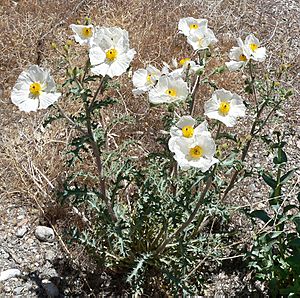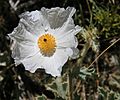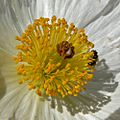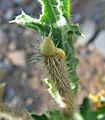Flatbud prickly poppy facts for kids
Quick facts for kids Flatbud prickly poppy |
|
|---|---|
 |
|
| Scientific classification | |
| Genus: |
Argemone
|
| Species: |
munita
|
The Flatbud Prickly Poppy, also known as Argemone munita, is a fascinating wild flower. People sometimes call it "chicalote." Its scientific name, "munita," means "armed." This is because the plant has many long, sharp prickles, like tiny weapons! You can find this poppy growing naturally in California. It's common across the western part of the state and in its eastern deserts. It also grows on mountain slopes up to 10,000 feet high and along roadsides. This poppy also grows in Baja California, Arizona, and Nevada.
Contents
What Does the Prickly Poppy Look Like?
This poppy grows on tall, spiky stems. These stems can stand over a meter (about 3 feet) tall! If you break a stem, you might see a yellow liquid, which is the plant's sap.
Leaves and Spines
The leaves of the Flatbud Prickly Poppy are a cool blue-green or mint-green color. They are also very prickly, just like the stems. The leaves are lobed, meaning they have rounded sections, almost like a hand with fingers.
Beautiful White Flowers
The flowers of this poppy are usually white. They have six crinkly petals, each up to 4 centimeters (about 1.5 inches) long. There are also three sepals, which are small leaf-like parts that protect the bud before it opens.
The Flower's Center
In the middle of the flower, you'll find a thick ring of up to 250 small yellow or orange parts called stamens. These stamens hold the pollen. Many people think these flowers look like "sunny-side-up eggs." The dark center of the flower can look like a tiny dot of pepper on top!
Spiky Fruit and Seeds
After the flower blooms, it forms spiny white capsules. These capsules are the fruit of the plant. They are usually 3 to 5 centimeters (about 1 to 2 inches) long. Each capsule holds many small seeds inside. The leaves and seeds of this plant contain natural chemicals. These chemicals are probably not safe to eat.






